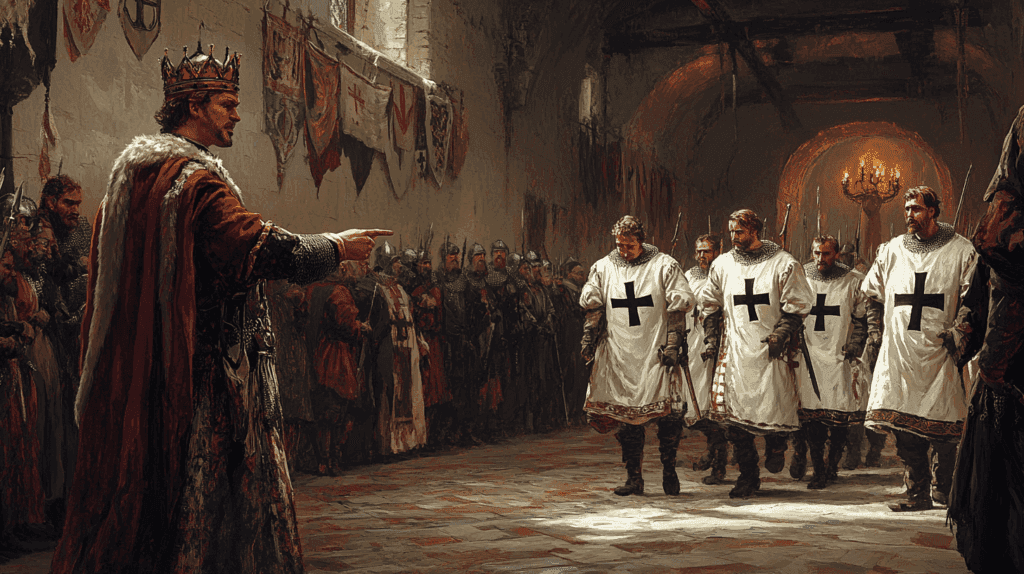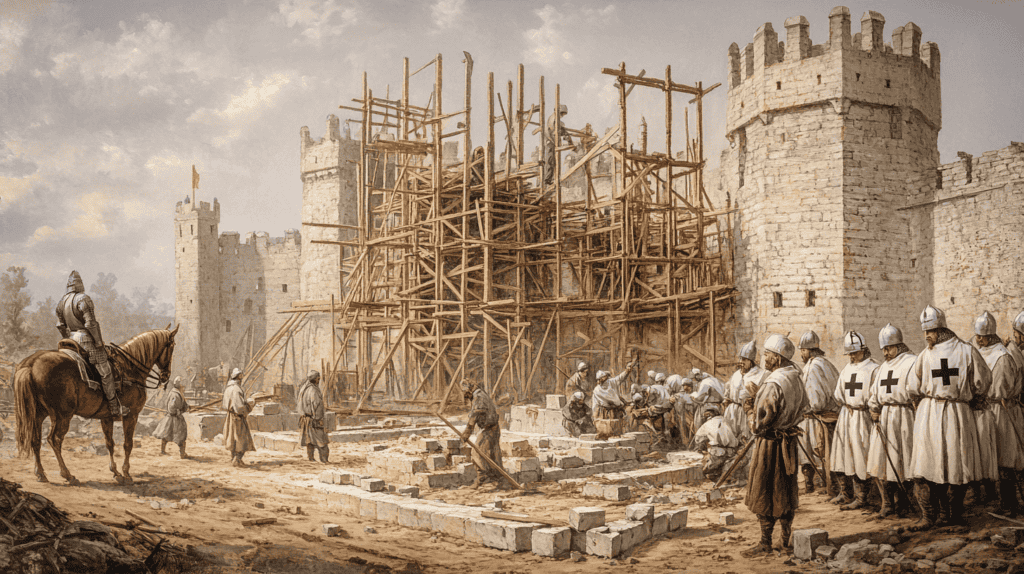
The Teutonic Knights, officially known as the less catchy Order of Brothers of the German House of Saint Mary in Jerusalem, emerged as a formidable military order in 1198, marking a pivotal shift from their humble beginnings as a hospital brotherhood during the Third Crusade. Their establishment formalized a unique fusion of monastic discipline and martial prowess that would reshape Northern Europe’s political and religious landscape.
Origins in the Third Crusade
The order traces its roots to the siege of Acre (1189–1191), where German crusaders under Duke Frederick VI of Swabia established a field hospital around 1190 to care for wounded pilgrims. This hospital initially operated under the auspices of the Hospitaller Order but soon developed a distinct German identity. Unlike the Templars and Hospitallers, the Teutonic Knights restricted membership to German-speaking nobles, creating a tightly knit organization aligned with the Holy Roman Empire’s interests.
By 1198, the failure to secure Jerusalem and growing tensions between European factions in the Holy Land prompted a strategic reevaluation. German nobles sought an independent military force to protect their interests, leading to the hospital’s transformation into a militant order.
The 1198 Ceremony: Birth of a Military Order

On March 5, 1198, a ceremony outside Acre’s walls formalized the Teutonic Order’s new role. Attended by the Patriarch Aymar of Jerusalem, King Amalric II of Jerusalem and the Masters of the Templar and Hospitaller Orders, the event symbolized ecclesiastical and royal endorsement of the order’s militarization.
Pope Innocent III’s 1199 bull, Sacrosancta romana, cemented this status by granting autonomy from local bishops, adopting the Templar military rule alongside Hospitaller charitable obligations and establishing their iconic uniform: a white mantle with a black cross.This dual mandate – care for the sick and combat against infidels – set them apart from other orders.
Their first Grand Master, Heinrich Walpot von Bassenheim, structured the organization into three classes:
- Knights (noble-born warriors)
- Priests (chaplains and administrators)
- Sergeants (non-noble support troops)
Strategic Expansion and Early Challenges
Initially confined to the Holy Land, the order faced existential threats after losing their base at Montfort Castle (1271) then Acre (1291) as Muslim forces expanded into the Crusader states. This forced a dramatic pivot toward Europe.

Hungary
In 1211, King Andrew II of Hungary invited the Teutonic Knights to defend the southeastern borders of his kingdom against the pagan Cuman tribes. This decision marked the beginning of a significant chapter in the history of both the Teutonic Order and the Kingdom of Hungary.
The Teutonic Knights were granted the district of Burzenland (Țara Bârsei) in Transylvania by King Andrew II. This region, located in the southeastern part of Transylvania, was strategically important as it was frequently targeted by Cuman raids. The king’s decision to invite the Teutonic Knights was primarily motivated by the need to establish a more effective defense against these nomadic incursions, which had proven the existing defensive system inadequate.

The Teutonic Knights in Burzenland
Upon their arrival, the Teutonic Knights, led by a brother called Theoderich or Dietrich, were tasked with defending the borders and were granted significant privileges. They were exempted from fees and duties and allowed to administer their own justice. This level of autonomy was intended to facilitate their primary mission of border defense.
The Knights quickly set about fortifying the region. They constructed numerous forts, initially using wood and mud, and later progressing to stone structures. By 1220, they had built five castles, significantly enhancing the defensive capabilities of the area. In addition to military construction, the Knights also engaged in settlement activities, bringing in new German peasants to live alongside the existing Transylvanian Saxon inhabitants.
Expansion and Conflict
As the Teutonic Knights established their presence in Burzenland, they began to expand their influence beyond their initial mandate. The Cumans, lacking fixed settlements, proved difficult to resist permanently, and the Knights soon found themselves pushing into Cuman territory. This expansion, while effective in terms of border defense, began to cause concern among the Hungarian nobility and clergy.
The rapid growth of Teutonic influence in the region led to jealousy and suspicion among the Hungarian elite, who had previously shown little interest in these borderlands. Some nobles began to claim lands that the Teutonic Order now controlled, but the Knights refused to share their newly acquired territories, effectively creating their own state. This refusal, coupled with their disregard for the demands of the local bishop, set the stage for future conflict.
Tensions with the Hungarian Crown
The relationship between the Teutonic Knights and the Hungarian crown began to deteriorate as the Order’s power and autonomy grew. King Andrew II, returning from the Fifth Crusade, found his kingdom resentful of the expenses and losses incurred during the failed campaign. The nobility demanded that he revoke the concessions made to the Knights, arguing that they had exceeded their original mandate.
While King Andrew initially resisted these demands, concluding that the agreement with the Knights should be revised rather than revoked, the situation continued to worsen. Prince Béla, the heir to the throne, allied himself with the nobility against the Teutonic Order, further complicating the political landscape.
The Teutonic Knights’ Fatal Mistake
In 1224, sensing the growing hostility and anticipating problems when Prince Béla would inherit the throne, the Teutonic Knights made a critical error in judgment. They petitioned Pope Honorius III to be placed directly under the authority of the Papal See, effectively bypassing the King of Hungary’s jurisdiction.
This move was seen as a direct challenge to Hungarian sovereignty and greatly angered King Andrew II. The king, alarmed by the Order’s growing power and their attempt to circumvent his authority, responded decisively in 1225 by expelling the Teutonic Knights from Hungary.

Expulsion
The expulsion of the Teutonic Knights from Burzenland had significant consequences for both the Order and the Kingdom of Hungary. While King Andrew allowed the German settlers brought in by the Knights to remain, forming part of the Transylvanian Saxon community, the loss of the Knights’ military expertise left a defensive void.
The Hungarians, lacking the military organization and experience of the Teutonic Knights, struggled to maintain adequate defenses against the Cuman threat. Soon after the Knights’ departure, the Cumans once again became a significant menace to the region.
The Teutonic Order initially moved their headquarters to Venice, planning to focus on the recovery of the Crusader states. However, this plan was soon abandoned when in 1226 Duke Conrad I of Masovia (in present day Poland), facing persistent raids from pagan Prussian tribes, invited the Teutonic Knights to assist in defending his lands and subduing the Prussian threat
Prussia
Conrad I, born around 1188, was the sixth Duke of Masovia and Kuyavia, ruling from 1194 until his death in 1247. Faced with the ongoing Prussian threat and unable to effectively defend his borders while simultaneously pursuing his political ambitions to unite the fragmented Polish provinces, Conrad sought external assistance. He entered into negotiations with the Teutonic Order, offering them a fief in the form of Chełmno Land in exchange for their military support against the Prussians.
Unbeknownst to Conrad, the Teutonic Knights, led by their Grand Master Hermann von Salza, had grander ambitions. As in Hungary, the Order sought to create its own state. Before accepting Conrad’s offer, they sought to secure their rights and future conquests through imperial sanction. In March 1226, Holy Roman Emperor Frederick II issued the Golden Bull of Rimini, a crucial document that would shape the future of the region.
The Golden Bull effectively granted the Teutonic Knights the right to conquer and rule Prussia, far exceeding the original scope of Conrad’s invitation. Importantly, the Bull declared that the land was “held under the sole rule of the Empire,” bypassing any claims of Polish sovereignty.
The Arrival of the Knights
The first Teutonic Knights, a small contingent of two knights and about a dozen servants, arrived in Chełmno Land in 1228. However, it wasn’t until 1230 that a larger force under the command of Hermann Balk crossed the Vistula River and began the conquest of Chełmno Land.
The Knights quickly established a foothold, constructing the castle of Toruń in 1231. This marked the beginning of their expansion and the establishment of what would become the Monastic State of the Teutonic Knights.

Papal Confirmation and Expansion
In 1234, Pope Gregory IX issued the Golden Bull of Rieti, further legitimizing the Teutonic Knights’ presence and conquests. This papal decree confirmed that the Order’s lands were subject only to the Pope, not to any secular ruler, including Conrad of Masovia.
The Knights rapidly expanded their control, building a network of castles and fortifications along the Vistula River and the Baltic coast and extending their influence into present-day Estonia and Latvia. The Knights’ crusade against the Prussians was characterized by brutal battles and forced conversions. The Old Prussian culture and religion were ruthlessly suppressed, with the local population either converted to Christianity or replaced by Christian settlers.

Legacy
The relationship between Conrad and the Order soon soured. In 1237, Conrad confiscated the Order’s lands and forced them to invest in the town of Dobrzyń. This action, however, did little to curb the Knights’ expansion and growing power. The Teutonic Knights had finally created their own state.
The Order’s power would continue to grow, and by 1407, would reach its greatest territorial extent, to include Prussia, Pomerelia, Samogitia, Courland, Livonia, Estonia, Gotland, Dagö, Ösel, and the Neumarkand.
Many centuries later, Napoleon declared the Order dissolved and redistributed most of its remaining lands. In 1834, the Austrian emperor refounded the Teutonic Order as a charitable religious organization. Today, the Order continues to operate, headquartered in Vienna, focusing on charitable and ceremonial duties.




